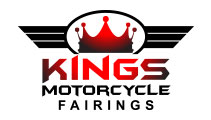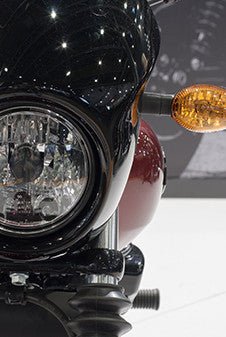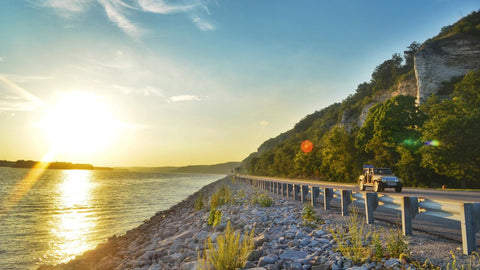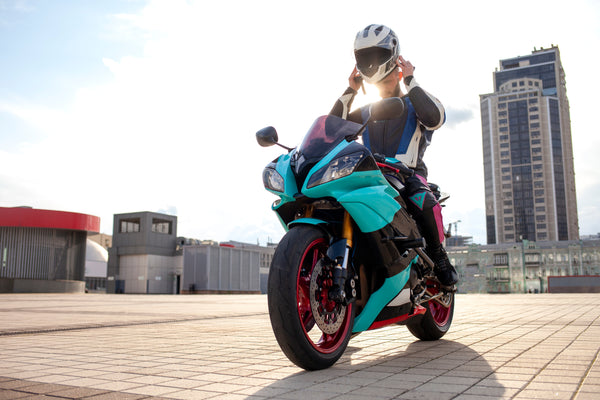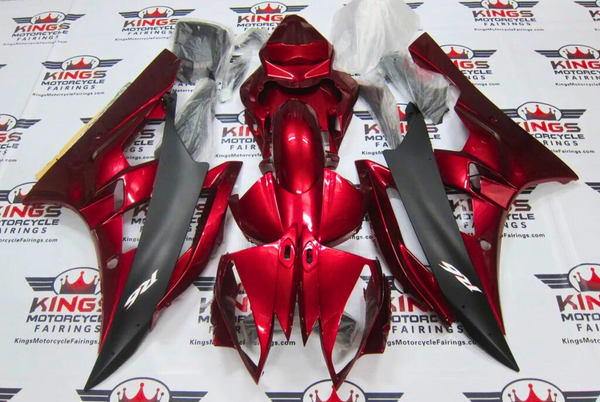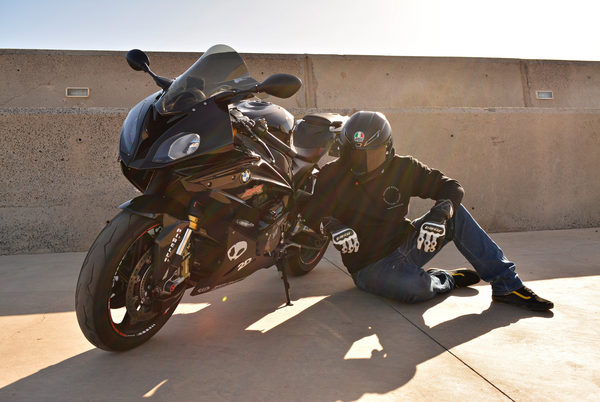News » article
-
Spring Awakening: Breathtaking Midwest Motorcycle Rides!
Spring Awakening: Breathtaking Midwest Motorcycle Rides By KingsMotorcycleFairings.com
Spring beckons motorcyclists across the Midwest. With warmer days and vibrant landscapes, it's the perfect time to explore the region's diverse offerings. From scenic lakes to charming towns, these rides offer something for everyone! Keep reading to discover some of the best Midwest motorcycle routes in the spring!
The Great River Road
(Minnesota, Wisconsin, Iowa, Illinois, Missouri - Over 3,000 miles):
- Experience: Embark on a majestic journey alongside the mighty Mississippi River. This epic route winds through five states, offering a diverse landscape unlike any other in the Midwest. Cruise past towering bluffs, quaint river towns brimming with history, and iconic landmarks like the Gateway Arch in St. Louis.
- Springtime Bonus: As spring awakens, lush greenery explodes along the riverbanks, transforming the scenery into a vibrant tapestry. Wildflowers add pops of color to meadows, creating a breathtaking spectacle for riders. Take a break and explore the charming towns along the way, soaking up the rich history and indulging in delicious local fare.
The North Shore Scenic Drive & Lake Superior Byway
(Minnesota, Wisconsin - Approximately 310 miles):
- Experience: Embrace the raw, invigorating beauty of Lake Superior on this scenic route. Traverse dramatic coastlines sculpted by glaciers, stopping to admire historic lighthouses standing sentinel over the vastness of the lake. Explore cascading waterfalls that tumble into the cool waters and charming harbor towns steeped in maritime history.
- Springtime Bonus: The crisp spring air provides a refreshing contrast to the cool lake breeze, making for an invigorating ride. The ever-changing colors of the lake add a dynamic element to the scenery. Witness the dramatic transition from icy blues to vibrant turquoise hues as the winter's grip loosens.
The Tunnel of Trees
(Michigan) - A Mystical 22-Mile Escape):
- Experience: Cruise beneath a dense canopy of trees on this iconic Michigan route. Sunlight filters through the leaves, creating a dappled light on the road for a truly unique riding experience.
- Springtime Bonus: Witness the vibrant green foliage replace the winter canopy, adding a touch of magic to your ride.
Spring paints the Midwest in a vibrant palette, and these motorcycle routes offer the perfect way to experience its beauty. From majestic rivers and dramatic coastlines to rolling hills and charming towns, there's an adventure waiting for every rider. So, fire up your engine, breathe in the fresh air, and explore the wonders of the awakening Midwest!
Remember: Spring weather can be unpredictable. Dress in layers, check weather forecasts, and be prepared for sudden changes.
The Team at KingsMotorCycleFairings.com wishes that you found this article helpful. If you have some extra time, we'd love for you to visit our online store for the largest selection of quality Motorcycle Fairing Kits, Helmets, Boots, Goggles, Backpacks, & Accessories!
-
Planning Your Custom Motorcycle Project
Planning Your Custom Motorcycle Project by KingsMotorcycleFairings.com
Ever dreamed of cruising down the road on a motorcycle unlike any other? One that reflects your unique style and personality, built with your own two hands? Building a custom motorcycle from scratch might seem daunting, but with the right guidance and quality parts, it's an achievable and incredibly rewarding journey. Here at KingsMotorcycleFairings.com, we're passionate about empowering riders to turn their visions into reality, so buckle up as we guide you through the exciting world of custom bike building!
Step 1: Laying the Foundation - Define Your Dream Machine
Before diving into tools and parts, envision your ideal motorcycle. Ask yourself:
- What riding style do I crave? (Sport bike, cruiser, cafe racer, chopper, etc.)
- What performance characteristics are important to me? (Speed, handling, comfort)
- What aesthetic speaks to my soul? (Classic, modern, minimalist)
Sketching your ideas and researching similar builds can solidify your vision and help you source the right components.
Step 2: Frame & Foundation - The Backbone of Your Beast
The frame is your bike's skeleton, so choose wisely. You can:
- Start with a pre-built frame: Offers a solid foundation and simplifies the process.
- Fabricate your own: Requires advanced metalworking skills but grants ultimate customization.
Remember, frame selection dictates many other component choices, so choose carefully!
Step 3: Powering Up - Choosing the Right Engine
The engine is the heart of your machine. Consider:
- Displacement and power: Align with your desired performance and riding style.
- Compatibility with your chosen frame: Ensure seamless integration.
- Source: New or used? New offers reliability, while used can be budget-friendly.
KingsMotorcycleFairings.com offers a wide selection of performance parts to fine-tune your engine's personality.
Step 4: Dressing Up Your Ride - Bodywork & Fairings
This is where your aesthetic vision truly comes to life! At KingsMotorcycleFairings.com, we offer:
- Premium fairings for popular motorcycle models: Enhance performance and personalize your style.
- Universal fairings: Create a one-of-a-kind look with endless customization options.
- High-quality materials: Ensure durability and a flawless finish.
Remember, proper fitment is crucial, so choose fairings compatible with your frame and riding style.
Step 5: The Final Touches - Personalization & Safety
Don't forget the details! Suspension, wheels, brakes, lighting, and accessories bring your vision to completion. Prioritize safety with high-quality components and ensure everything complies with local regulations.
Building a custom motorcycle is an unforgettable journey. With dedication, the right parts, and a little help from KingsMotorcycleFairings.com, you can turn your dream machine into reality. Remember, the road to a one-of-a-kind ride starts with a spark of inspiration and a willingness to get your hands dirty. So, unleash your inner engineer, grab your tools, and start building the motorcycle that defines you!
Disclaimer: This blog post is intended for informational purposes only and should not be considered professional advice. Always consult with qualified professionals and ensure you possess the necessary skills and knowledge before undertaking any motorcycle modifications.
The Team at KingsMotorCycleFairings.com wishes that you found this article helpful. If you have some extra time, we'd love for you to visit our online store for the largest selection of quality Motorcycle Fairing Kits, Helmets, Boots, Goggles, Backpacks, & Accessories!
-
The Impact of Motorcycle Fairings on Fuel Efficiency
The Impact of Motorcycle Fairings on Fuel Efficiency by KingsMotorcycleFairings.com
When it comes to the world of motorcycles, enthusiasts are constantly seeking ways to enhance performance, speed, and efficiency. One often overlooked aspect that plays a significant role in a motorcycle's efficiency is its fairings. At KingsMotorcycleFairings.com, we understand the importance of every component in optimizing your riding experience. In this blog post, we'll explore the impact of motorcycle fairings on fuel efficiency.
Streamlined Aerodynamics:
Motorcycle fairings are not just aesthetic additions; they serve a crucial purpose in improving the aerodynamics of the bike. By reducing air resistance, fairings enable the motorcycle to cut through the wind more efficiently. This streamlined design minimizes drag, allowing the bike to achieve higher speeds with less effort. Consequently, the engine doesn't have to work as hard to propel the motorcycle forward, ultimately leading to improved fuel efficiency.
Wind Protection:
Apart from aiding in aerodynamics, fairings also provide essential wind protection for the rider. Riding at high speeds exposes the motorcycle and its rider to substantial wind force. Fairings act as a shield, redirecting the wind away from the rider and creating a smoother riding experience. This not only enhances comfort but also reduces the rider's resistance against the wind, contributing to fuel efficiency.
Reduced Turbulence:
Motorcycles without fairings tend to create turbulent air patterns around the engine and other exposed parts. This turbulence can disrupt the airflow and lead to increased drag. Fairings, however, help in directing air smoothly around the motorcycle, reducing turbulence. The result is a more stable and controlled ride, requiring less fuel to maintain speed and momentum.
Weight Considerations:
While fairings are primarily designed for aerodynamics, their material and design can also impact the overall weight of the motorcycle. Modern fairings are often crafted from lightweight materials, minimizing the additional load on the bike. A lighter motorcycle demands less energy to accelerate and maintain speed, positively affecting fuel efficiency.
In the pursuit of enhancing motorcycle performance, riders should not underestimate the impact of fairings on fuel efficiency. At KingsMotorcycleFairings.com, we offer a range of high-quality fairings designed to not only elevate the aesthetics of your ride but also contribute to a more fuel-efficient and enjoyable experience on the road. Investing in well-designed fairings is not just about style; it's about unlocking the full potential of your motorcycle's performance while being mindful of fuel consumption. Ride efficiently, ride stylishly with KingsMotorcycleFairings.com.
The Team at KingsMotorCycleFairings.com wishes that you found this article helpful. If you have some extra time, we'd love for you to visit our online store for the largest selection of quality Motorcycle Fairing Kits, Helmets, Boots, Goggles, Backpacks, & Accessories!
-
Winterizing Your Bike: Protecting Fairings from the Cold
Winterizing Your Bike: Protecting Fairings from the Cold by KingsMotorcycleFairings.com
Winter is fast approaching, and as temperatures drop, it's essential to ensure that your motorcycle is prepared to weather the chill. At KingsMotorcycleFairings.com, we understand the importance of safeguarding your bike's aesthetics and functionality, particularly its fairings, during the colder months. Follow our simple guide to winterize your bike and protect those sleek fairings from the harsh elements.
1. Clean and Inspect:
Before winter sets in, give your bike a thorough cleaning. Remove any dirt, grime, or salt accumulated during your rides. Inspect the fairings for any existing damage or scratches. Addressing these issues before winter will prevent them from worsening in the cold.
2. Apply a Protective Coating:
Invest in a high-quality wax or sealant designed for motorcycle fairings. Applying a protective coating creates a barrier against the elements, shielding the fairings from snow, sleet, and freezing rain. KingsMotorcycleFairings.com offers a range of products suitable for this purpose.
3. Consider a Fairing Cover:
For added protection, consider using a fairing cover. These covers are designed to fit snugly over your bike's fairings, providing an extra layer of defense against winter weather. KingsMotorcycleFairings.com offers covers that are both durable and weather-resistant.
4. Avoid High-Pressure Washing:
While it's essential to keep your bike clean, avoid using high-pressure washers on the fairings during winter. High-pressure water can seep into small cracks or openings, leading to potential issues as temperatures drop.
5. Elevate and Cover:
If possible, store your motorcycle off the ground to prevent direct contact with the cold surface. Use a quality motorcycle cover to shield the entire bike, including the fairings, from winter elements. This also helps in maintaining the overall condition of your motorcycle.
6. Regular Checkups:
Throughout the winter months, conduct regular checkups on your bike. Inspect the fairings for any signs of damage or issues. If you notice anything concerning, address it promptly to avoid complications when the riding season returns.

By taking these simple steps, you can ensure that your motorcycle fairings remain in top condition, ready to hit the road when the warmer weather returns. KingsMotorcycleFairings.com is here to support your journey through all seasons, providing quality products to keep your bike looking and performing its best. Stay tuned for more tips and insights to elevate your riding experience. Safe winter riding!
The Team at KingsMotorCycleFairings.com wishes that you found this article helpful. If you have some extra time, we'd love for you to visit our online store for the largest selection of quality Motorcycle Fairing Kits, Helmets, Boots, Goggles, Backpacks, & Accessories!
-
The Influence of Fairings on Motorcycle Resale Value
The Influence of Fairings on Motorcycle Resale Value by KingsMotorcycleFairings.com
As motorcycle enthusiasts, we take pride in our rides, cherishing every moment on the open road. However, the world of motorcycles goes beyond the thrill of the ride; it's also about making wise investments. One crucial factor that often affects a motorcycle's resale value is the presence of fairings. In this blog post, brought to you by KingsMotorcycleFairings.com, let's explore how fairings can influence the resale value of your beloved bike.
1. Aesthetics Matter: First impressions are lasting impressions. The aesthetic appeal of a motorcycle can significantly impact its resale value. Well-maintained fairings not only protect the bike but also contribute to its overall visual appeal. Potential buyers are more likely to be drawn to a motorcycle that looks sleek and well-cared-for, thanks in part to the presence of stylish and intact fairings.
2. Protection Against Wear and Tear: Fairings play a crucial role in shielding your motorcycle from the elements. They protect the engine, frame, and other vital components from dirt, debris, and weather conditions. A bike with well-preserved fairings is likely to have fewer signs of wear and tear, translating to a higher resale value. Buyers often appreciate a motorcycle that has been well-protected throughout its life.
3. Preserving Performance: Beyond aesthetics, fairings contribute to the overall performance of a motorcycle. They enhance aerodynamics, reduce drag, and provide wind protection for the rider. A bike that performs well is more likely to retain its value over time. Prospective buyers are often willing to pay a premium for a motorcycle that not only looks good but also offers a smooth and efficient riding experience.
4. Documentation of Maintenance: When it comes time to sell your motorcycle, having a record of regular maintenance, including fairing inspections and replacements, can instill confidence in potential buyers. It demonstrates your commitment to keeping the bike in top condition and can positively influence the resale value.
Investing in quality fairings is not just about enhancing the look and performance of your motorcycle; it's a strategic move to preserve its resale value. At KingsMotorcycleFairings.com, we offer a range of premium fairings designed to protect your bike and maintain its aesthetic appeal. Choose wisely, invest in quality, and ride with the assurance that you're not just enjoying the journey, but also safeguarding the value of your motorcycle for the future.
The Team at KingsMotorCycleFairings.com wishes that you found this article helpful. If you have some extra time, we'd love for you to visit our online store for the largest selection of quality Motorcycle Fairing Kits, Helmets, Boots, Goggles, Backpacks, & Accessories!
